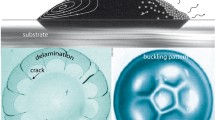Abstract
We examined the drying behavior of latex both theoretically and experimentally. The theory extends a model for horizontal drying fronts in films with nondeformable particles to incorporate particle deformation by a capillary deformation mechanism. The pressure in the fluid, causing particle compaction, arises from flow through the packed bed to ensure evaporation from all wet areas of the film. We predicted the position of a front of volume fraction unity passing across a semi-infinite film as it dries. Experimentally, the position of the transition from a cloudy film to optical clarity was tracked visually in films comprised of either single component soft latex particles, 20°C above the glass transition, or a blend containing 35% non-deformable hard latex particles. For an initial volume fraction of 0.33, we found excellent agreement between theory and experiment. For an initial volume fraction of 0.05, the agreement is less, although still qualitative. The limitations of the model with respect to the knowledge of physical parameters and initial conditions are discussed. One major implication of the model is that deformation of soft latex particles displaces large amounts of water and, consequently, slows progression of the drying front. Harder particles and shallow initial film profiles produce more pronounced drying fronts.
Similar content being viewed by others
References
Sheetz, D.P., “Formation of Films by Drying of Latex,”J. Appl. Polym. Sci., 9:3759–3773, 1995.
Croll, S.G., “Drying of Latex Paint,”Journal of Coatings Technology, 58, No. 734, 41 (1986).
Winnik, M.A. and Feng, J., “Latex Blends: An Approach to Zero VOC Coatings,”Journal of Coatings Technology, 68, No. 852, 39 (1996).
Routh, A.F. and Russel, W.B., “Horizontal Drying Fronts During Solvent Evaporation from Latex Films,”AIChE J., 44 (9), 2088–2098 (1998).
Vanderhoff, J.W., Tarkowski, H.L., Jenkins, M.C., and Bradford, E.B., “Theoretical Consideration of the Interfacial Forces Involved in the Coalescence of Latex Particles,”J. Macromol. Chem., 1 (2), 361–397 (1996).
Dillon, R.E., Matheson, L.A., and Bradford, E.B., “Sintering of Synthetic Latex Particles,”J. Colloid Sci., 6 (2), 108–117 (1951).
Brown, G.L., “Formation of Films from Polymer Dispersion,”J. Polym. Sci., 22, 423–434 (1956).
Routh, A.F. and Russel, W.B., “A Process Model for Latex Film Formation: Limiting Regimes for Individual Driving Forces,”Langmuir, 15 (22), 7762–7773 (1999).
Kerker, M.,The Scattering of Light and Other Electromagnetic Radiation, Academic Press, 1969.
Van Tent, A. and Nijenhuis, K.Te., “Turbidity Study of the Process of Film Formation of Polymer Particles in Drying Thin Films of Acrylic Latices. I. Intrastructure of Acrylic Latices Studied with Transmission Spectrophotometry,”J. Colloid Interface Sci., 150 (1), 97–114 (1992).
Tang, J., Dimonie, V.L., Daniels, E.S., Klein, A., and El-Aasser, M.S., “Synthesis and Characterization of Model Carboxylated Latexes for Studies of Film Formation from Latex Blends,”J. Appl. Polym. Sci., in press.
Ahmed, S.M., El-Aasser, M.S., Pauli, G.H., Poehlein, G.W., and Vanderhoff, J.W., “Cleaning Latexes for Surface Characterization by Serum Replacement,”J. Colloid Interface Sci., 73, (2), 388 (1980).
Van Den Hul, H.J. and Vanderhoff, J., “The Characterization of Latex Particle Surface by Ion Exchange and Conductometric Titration,”J. Electroanal. Chem. Interfacial Electrochem., 37, 161 (1972).
Kamel, A.A., El-Aasser, M.S., and Vanderhoff, J.W., “The Preparation and Surface Characterization of an Ideal Model Colloid,”J. Dispersion Sci and Technol., 2, (2 and 3), 183–214 (1981).
Winnik, M.A., inEmulsion Polymerization and Emulsion Polymers, Chapter 14, pp. 467–517, Lovell, P.A. and El-Aasser, M.S. (Eds.), John Wiley and Sons Ltd., 1997.
Huheey, J.E.,Inorganic Chemistry, Harper and Row, 1978.
Author information
Authors and Affiliations
Additional information
Dept. of Chemical Engineering, Princeton, NJ 08544.
Emulsion Polymers Institute and Dept. of Chemical Engineering, Bethelhem, PA 18015.
Rights and permissions
About this article
Cite this article
Routh, A.F., Russel, W.B., Tang, J. et al. Process model for latex film formation: Optical clarity fronts. Journal of Coatings Technology 73, 41–48 (2001). https://doi.org/10.1007/BF02698430
Issue Date:
DOI: https://doi.org/10.1007/BF02698430




